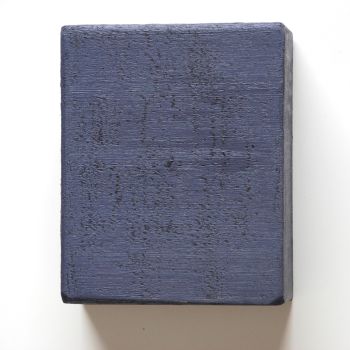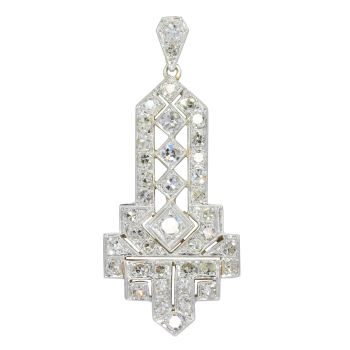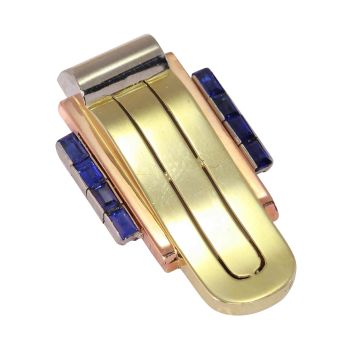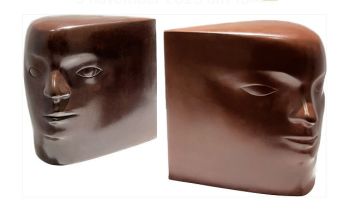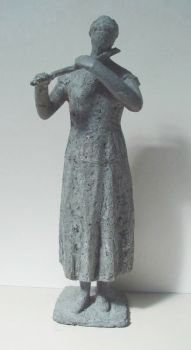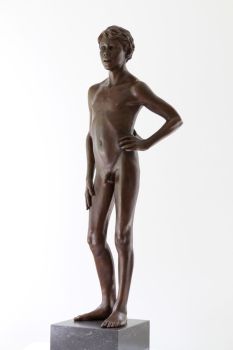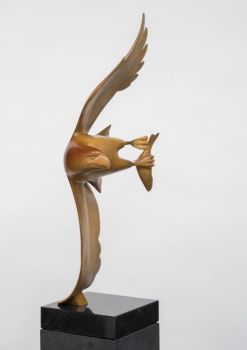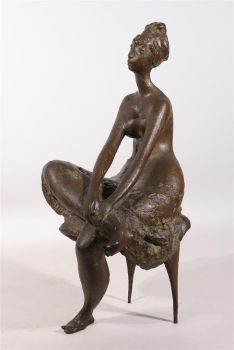Reclining cubist man 1932
Léon Indenbaum
BronceMetal
14 ⨯ 40 ⨯ 12 cm
ConditionExcellent
Precio a consultar
Dille Art
- Sobre la obra de arteBeautiful cubist sculpture of a reclining man, cast in bronze. It is a design by Léon Indenbaum from 1932. This sculpture was cast posthumously by the family in a small exclusive edition. This is number 5/8.
The sculpture is extensively signed with number and stamp of the foundry. It is cast cire perdue (lost wax technique); 'Inden', 'Barthélemy' and '5/8'.
The family had this sculpture cast in bronze posthumously, because the family believes that their grandfather's sculptures should be seen, they want to give the name Indenbaum the attention and fame it deserves, in their opinion. Léon Indenbaum is known to connoisseurs and is inextricably linked to the Ecole de Paris. Yet they only want to sell a few works, to a very limited extent.
These posthumous sculptures are therefore a first and also the last edition of a maximum of 12. Each sculpture is numbered and officially registered, maximum 8 are numbered 1-8 and four of them are signed EA I to EA IV. (EA stands for Epreuve d'Artiste). This is number 5/8. They cast every sculpture one by one, at the moment only 5 examples exist. More than 12 examples will not be cast either.
This work also includes an official certificate signed by Léon Indenbaum's grandson. This sculpture with certificate is also registered with ADAGP (Société des authors dans les arts graphiques et plastiques) in Paris.
Biography:
Leon Indenbaum (Tcherikov, now Belarus, 1890 - Opio, 1981), was a Russian/French sculptor who belonged to the group of artists of the École de Paris. His art was innovative, inspired by the classics, but also by African art, the Cubism and Expressionism.
Léon Indenbaum grew up in the shtetl (Eastern European Jewish village) Tcherikov, with his grandfather, who was a bookbinder of art books. After primary school, he was educated as a woodworker. The director of that school thought he was so talented that he arranged for him to attend the Academy of Decorative Arts in Vilnius.
After this training, Indenbaum wanted more and was admitted to the Imperial Academy in Odessa. He went through it for a few years until he crossed a wrong box on a form, he had accidentally signed for 5 years military service in the Imperial Army.
He already had contacts with an artist friend who was in Paris, where so much was happening in the field of art.
Indenbaum managed to escape from Vilnius with the help of an engineer and arrived in Paris in March 1911.
He ended up in 'La Ruche' in Montparnasse, a kind of artists' village.
La Ruche was a circular building, it served as a wine pavilion at the 1900 World's Fair, and was rebuilt by the successful artist Alfred Boucher. Boucher wanted to give poor artists a chance to devote themselves completely to their art. La Ruche was a large round building full of studio apartments, each room had the shape of a slice of pie, in the point a space for a kitchen and storage and above the door was a small loft where you could sleep, often such a studio also had to be shared.
Indenbaum got a studio on the 2nd floor, next to Chagall, who, like himself, had also just arrived from Russia. Indenbaum lived in La Ruche until 1927.
He did have a second studio in Montparnasse for a while.
In total, about 200 artists lived in La Ruche, many of them were from Eastern Europe and many of them were Jewish. Some of them have become world famous with their art, think of Chaïm Soutine, Ossip Zadkine, Jacques Lipschitz, Chana Orloff, Michael Kikoïne, Moïse Kisling , Amadeo Modigliani to name a few.
From 1911 to 1919, Indenbaum studied
sculpture at the Académie La Grande Chaumière, his mentor was the sculptor and painter Antoine Bourdelle, first as a student, later also as his assistant.
In 1912 Indenbaum already exhibited at the Paris Salon d'Artistes Indépendents, he was very poor and his choice of materials was cheap. Jacques Doucet, the great art collector and famous couturier, saw a bust of Indenbaum and summoned him to his home, he wanted the same bust made in a different material, Indenbaum managed to get a piece of onyx.
Doucet was very pleased and asked Indenbaum to make a relief for his round dining room. Indenbaum received 1000 francs per month. Indenbaum had found his patron.
He made one of his most impressive reliefs, entitled 'Musiciens et antelopes' from 1914, made of pink onyx. It was auctioned at Christie's in 2004 for 3.3 million euros.
Besides Jacques Doucet, the couturier René Poiret, the bankers George and Marcel Bénard and the decorator, designer and collector Marcel Coard were regular customers of Léon Indenbaum's sculptures and reliefs.
Léon fell in love with Céline Hénin, she became his muse and his wife, at the end of 1914 they had a daughter, Dinah. Indenbaum was doing well. He had many friends, such as the artists Chaim Soutine, Amadeo Modigliani, with whom he also shared a studio for a period, Tsuguharu Foujita, Chana Orloff, Michael Kikoïne, and Diego Rivera.
Amadeo Modigliani and Diego Rivera both portrayed Indenbaum in 1913 and 1916. Indenbaum himself also portrayed several of his friends. It was the happiest period of his life.
With the stock market crash of 1929, life became much more difficult, people lost their fortunes and could no longer afford works of art. The political situation in France also changed.
The artists from La Ruche and Montparnasse were mostly migrants, at the Paris Salon they were not allowed to exhibit their work among the French artists, an art critic, André Warnod, had given them the nickname 'École de Paris', to show that this innovative avant-garde garde art was also French art. In the 1930s this name was used derogatorily, they were looked down upon, their art was called depraved and because many of them were Jewish, there was also anti-Semitism. They were ignored in the press and in the late 1930s they were no longer allowed to exhibit.
Some artists went abroad. When the war broke out, many had to flee or go into hiding. Indenbaum also had to leave Paris in a hurry. He found a hiding place in a village in the Seine et Marne, where he always got his clay. He was lucky and survived the war, more than 60 percent of the Jewish artists in La Ruche died in the camps.
After the war, Indenbaum settled in Paris again. His studio had been looted and what was left was sometimes destroyed. He lived a very withdrawn life. He had already been separated from Céline before the war, his daughter lived in the south of France. His friends had either not survived the war or had become much too commercial in his view.
He never wanted to commit to a gallery, he felt that he sold his soul, his independence as an artist was at stake, the result was that he was ignored by a large part of the art world. His now famous friends had signed and they were doing well.
Indenbaum wanted nothing more than to work in complete freedom, but in doing so he made it very difficult for him self. He also refused, for example, major commissions from the French state for work on monuments and facades of special buildings.
He was, however, one of the founders of the "Groupe des neuf", a group of nine sculptors who gathered on November 11, 1963 at the statue of Balzac on Avenue Raspail, made by Auguste Rodin.
It was a tribute. They wanted to create a monument to French post-war figurative sculpture at a time when American art was beginning to take over.
The 'Groupe des neuf' consisted of Jean Carton, Paul Cornet, Raymond Corbin, Marcel Damboise, Léon Indembaum, Léopold Kretz, Raymond Martin, Gunnar Nilsson and Jean Osouf. It was a success, there were several exhibitions ofthe group, including in Musée Rodin, a total of 22 sculptors joined the group.
In 1968 Indenbaum received the prestigious Prix de sculpture Georges Wildenstein, from the Institut de France, for his entire oeuvre. In the same year he decided to move to his daughter in Opio. He died at the age of 91. A long life entirely devoted to creating art.
Léon Indenbaum's work can be seen in various museums, including in the United States, Switzerland, Russia, Belarus, Israel and of course in France. Sometimes his work is also auctioned at the major auction houses such as Christies, Sotheby's and MacDougall in London. - Sobre el artista
Léon Indenbaum (Tcherikov, ahora Bielorrusia, 1890 - Opio, 1981), fue un escultor ruso / francés perteneciente al grupo de artistas de la École de Paris. Su arte fue innovador, inspirado en los clásicos, pero también en el arte africano, el cubismo y el expresionismo.
Indenbaum creció en el shtetl (pueblo judío de Europa del Este) Tcherikov, con su abuelo, que era encuadernador de libros de arte. Después de la escuela primaria, se formó como carpintero. El director de esa escuela pensó que tenía tanto talento que organizó que asistiera a la Academia de Artes Decorativas de Vilnius.
Después de este entrenamiento, Indenbaum quería más y fue admitido en la Academia Imperial de Odessa. Lo pasó por unos años hasta que marcó una casilla incorrecta en un formulario, había firmado accidentalmente por 5 años de servicio militar en el Ejército Imperial. Ya tenía contactos con un amigo artista que estaba en París, donde estaban sucediendo tantas cosas en el campo del arte. Indenbaum logró escapar de Vilnius con la ayuda de un ingeniero y llegó a París en marzo de 1911.
Terminó en 'La Ruche' de Montparnasse, una especie de aldea de artistas. La Ruche era un edificio circular, sirvió como pabellón de vinos en la Exposición Universal de 1900 y fue reconstruido por el exitoso artista Alfred Boucher. Boucher quería dar a los artistas pobres la oportunidad de dedicarse por completo a su arte. La Ruche era un gran edificio redondo lleno de apartamentos tipo estudio, cada habitación tenía la forma de una rebanada de pastel, en el punto un espacio para una cocina y almacenamiento y encima de la puerta había un pequeño loft donde se podía dormir, a menudo como un estudio. también tenía que ser compartido.
Indenbaum consiguió un estudio en el segundo piso, al lado de Chagall, quien, como él, también acababa de llegar de Rusia. Indenbaum vivió en La Ruche hasta 1927. Tuvo un segundo estudio en Montparnasse durante un tiempo.
En total, unos 200 artistas vivían en La Ruche, muchos de ellos de Europa del Este y muchos de ellos judíos. Algunos de ellos se han hecho mundialmente famosos con su arte, piense en Chaïm Soutine, Ossip Zadkine, Jacques Lipschitz, Chana Orloff, Michael Kikoïne, Moïse Kisling, Amadeo Modigliani, por nombrar algunos.
De 1911 a 1919, Indenbaum estudió escultura en la Académie La Grande Chaumière con el escultor y pintor Antoine Bourdelle, primero como estudiante y luego también como su ayudante.
En 1912, Indenbaum ya expuso en el Salón de Artistes Independientes de París, era muy pobre y su elección de materiales era barata. Jacques Doucet, el gran coleccionista de arte y famoso modisto, vio un busto de Indenbaum y lo convocó a su casa, quería el mismo busto hecho en un material diferente, Indenbaum logró hacerse con una pieza de ónix. Doucet estaba muy complacido y pidió a Indenbaum que hiciera un alivio para su comedor redondo. Indenbaum recibía 1000 francos al mes. Indenbaum había encontrado a su patrón. Realizó uno de sus relieves más impresionantes, titulado 'Musiciens et antílopes' de 1914, hecho de ónix rosa. Fue subastado en Christie's en 2004 por 3,3 millones de euros.
Además de Jacques Doucet, el modisto René Poiret, los banqueros George y Marcel Bénard y el decorador, diseñador y coleccionista Marcel Coard eran clientes habituales de las esculturas y relieves de Léon Indenbaum.
Léon se enamoró de Céline Hénin, ella se convirtió en su musa y en su esposa, a finales de 1914 tuvieron una hija, Dinah. Indenbaum estaba bien. Tuvo muchos amigos, como los artistas Chaim Soutine, Amadeo Modigliani, con quien también compartió estudio por un tiempo, Tsuguharu Foujita, Chana Orloff, Michael Kikoïne y Diego Rivera.
Amadeo Modigliani y Diego Rivera interpretaron a Indenbaum en 1913 y 1916. El propio Indenbaum también interpretó a varios de sus amigos. Fue el período más feliz de su vida.
Con el colapso de la bolsa de valores de 1929, la vida se volvió mucho más difícil, la gente perdió su fortuna y ya no podía permitirse el lujo de obras de arte. La situación política en Francia también cambió. Los artistas de La Ruche y Montparnasse eran en su mayoría inmigrantes, en el Salón de París no se les permitía pasar el rato entre los artistas franceses, un crítico de arte, André Warnod, les había puesto el sobrenombre de 'École de Paris', para demostrar que este innovador El arte de vanguardia fue también arte francés. En la década de 1930 se usaba este nombre de manera despectiva, se los despreciaba, se llamaba depravado a su arte y como muchos de ellos eran judíos, también existía el antisemitismo. Fueron ignorados en la prensa y, a finales de la década de 1930, ya no se les permitió exhibir. Algunos artistas se fueron al extranjero. Cuando estalló la guerra, muchos tuvieron que huir o esconderse. Indenbaum también ha tenido que salir de París a toda prisa. Encontró un escondite en un pueblo de Seine et Marne, donde siempre conseguía su arcilla. Tuvo suerte y sobrevivió a la guerra, más del 60 por ciento de los artistas judíos en La Ruche murieron en los campos.
Después de la guerra, Indenbaum se instaló nuevamente en París. Su estudio había sido saqueado y lo que quedaba a veces era destruido. Vivía muy retraído. Ya había sido separado de Céline antes de la guerra, su hija vivía en el sur de Francia. Sus amigos no habían sobrevivido a la guerra o se habían vuelto demasiado comerciales en su opinión.
Nunca quiso comprometerse con una galería, sintió que vendió su alma, estaba en juego su independencia como artista, el resultado fue que fue ignorado por gran parte del mundo del arte. Sus ahora famosos amigos habían firmado y les iba bien. Indenbaum no quería nada más que trabajar con total libertad, pero al hacerlo se arrojó sus propias gafas. También se negó, por ejemplo, a importantes encargos del estado francés para trabajos en monumentos y fachadas de edificios especiales.
En 1968, Indenbaum recibió el prestigioso Prix de sculpture Georges Wildenstein, del Institut de France por toda su obra. En los últimos años vivió con su hija en Opio. Murió a los 91 años. Una larga vida dedicada íntegramente a la creación de arte.
El trabajo de Léon Indenbaum se puede ver en varios museos, incluso en los Estados Unidos, Suiza, Rusia, Bielorrusia, Israel y, por supuesto, en Francia. A veces, su trabajo también se subasta en las principales casas de subastas como Christies, Sotheby's y MacDougall en Londres.
¿Está interesado en comprar esta obra de arte?
Artwork details
Related artworks
- 1 - 4 / 5
Marc Chagall
Booz se reveille et voit Ruth a ses Pieds1952 - 1980
Precio a consultarArthouse Marc Chagall
1 - 4 / 24Klaas II Mobach
Hanna Mobach, daughter of the sculptor Klaas Mobach, reading1950 - 1970
Precio a consultarKunsthandel Pygmalion
1 - 4 / 24- 1 - 4 / 24
- 1 - 4 / 24
Artista Desconocido
Japanese art deco lacquervase with Scarab beetle motif1920 - 1950
Precio a consultarDille Art
1 - 4 / 12






















